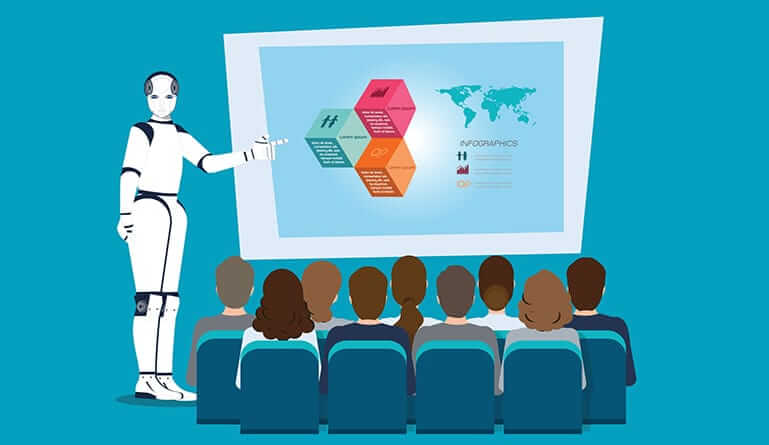Guest Contribution by Harish Agrawal
Remember Raj in Big Bang Theory? When he was first introduced to Siri, he was totally enamored by the virtual assistant, who could even be referred to for a wine recommendation! Apple’s “Speech Interpretation and Recognition Interface,” or Siri as it is more lovingly called, has today become one of the most ubiquitous virtual assistants on the market.
But that is just one of the few virtual assistants in use today. From auto-responders to chatbots, consumer-facing businesses have embraced virtual assistants in one form or another. And, the applications of AI for business doesn’t stop there either. Any communication that can be broken down into repetitive patterns of responses can be managed by a virtual assistant or personal facilitator, as we like to call them.
As a decision-maker for the organization, it means that you get to ease processes for your employees, right from a new hire to the senior management. With AI, you have the facility to automate a lot of your own routine tasks too, while ensuring timely and accurate responses to standard queries. In short, you can ensure 24/7 support and guidance.
For the L&D departments, virtual assistants can ensure anytime, anywhere learning – a win-win for the employee as well as the organization.
The Science Behind Virtual Assistants
One of the most interesting and endearing features of virtual assistants is their “human-like” conduct. This comes from the interplay between two technological breakthroughs: Artificial Intelligence and Natural Language Processing (NLP). These systems are designed with the ability to listen (for voice-activated systems), understand and respond to user queries, based on available information.
Depending on the complexity of the system, virtual assistants for the HR and L&D departments typically integrate with global HRMS/LMS platforms, active directories and other systems that are already in use. They are easy to set up and configure, with policy and process documents (which can be uploaded in multiple formats, such as PDF, Excel, and Word, to name the most common) and offer detailed analytics and insights into employee learning, most read/sought information, and so on.
Depending on the complexity of the training or office assistant being deployed, there are 4 stages that a typical command goes through:
Stage 1: Voice Recognition:
The data file that is generated by a voice command has to account for language, accent, and dialect while processing for ambient noise. This stage is the most difficult part of the process.
Stage 2: Connecting to Servers or Databases:
With mapped queries and responses.
Stage 3: Understanding the Query:
This is where AI and machine learning step in. For example, if a new hire needs clarity on a form, a human would simply look over and tell them what they need to fill in. An effective chatbot or personal facilitator should be able to replicate the same kind of response.
Stage 4: Provide an Appropriate Response:
For this, the system will need to interact with other systems, files, and related documents, and present the results to the user either by “replying” verbally or throwing up a text-based response.
How Smart are “Smart Learning Assistants”?
Smart learning facilitators are designed to mimic human learning. So, while they are great for addressing standard queries and working through standard processes, they can also take on higher-order functions, such as delivering training and generating assessment reports. These assistants are available and learn on the go. As a result, they ensure improved response time to common queries, while also providing meaningful feedback and insights into learning behavior and employee readiness, aptitude and skill gaps.
Intelligent assistants are not here to replace human instructors in corporate training. It is quite the opposite. They are here to help organizations achieve better results. In fact, personal learning facilitators can prove quite useful in procedural learning, since they can be programmed to provide advice to struggling learners. Since learners are interacting with what is, ultimately, faceless software, they also would feel more comfortable asking “silly questions” and less embarrassed about asking the program to repeat information.
From a time and resource management perspective, smart assistants serve multiple users simultaneously, while tracking individual learning and generating customized learning paths, making learning efficient, available and dependable. As a trainer, there could be times when assessments do not yield the results of employees expected. Using a virtual assistant limits the scope for interpersonal friction that may stem from someone being denied a promotion (for example) that they thought they deserved but did not yet have the skills to be able to deliver on.
Catering to the New Age Employee
The marketplace for virtual assistants is global. Technology and interconnectedness are becoming so universal that anyone who needs to interact with a brand or a business or even with another human being will end up interacting with a smart “machine” at some point. However, the true target group is the techno-savvy millennial.
Millennials are the largest generation in US history. Numbering over 80 million, this age group has not only reshaped markets but as the volume of their presence in the labor pool increases, this generation has and will continue to transform workplaces.
As L&D delivery shifts in favor of millennial preferences, the smart learning assistant market will explode. In fact, according to some estimates, the intelligent virtual assistant market will be worth nearly $20 billion by 2025. The future is here but are you ready to embrace it?
What Does the Future Hold?
Today’s business aims to be agile, adapting rapidly to the equally swift technological advancements. But, to ensure that training occurs not just in the flow of work but at the speed of business, only an agile solution like an AI-powered learning experience platform can help that enables quick modification and addition of content, creation of courses and fast deployment across departments, locations and roles.
In addition, if the platform is compatible across multiple devices, from laptops to tablets and smartphones, as well as various operating systems, such as iOS, Android and Windows, access to content and courses can be optimized. Training becomes engaging and personalized with an intelligent assistant, regardless of whether it is related to organizational information, policies or processes.
From groans around productivity loss due to training to whoops around frivolous off-sites, no model for delivering employee learning and development has managed to stick to and deliver on its one true agenda – learning. Yes, the average human being is constantly learning – from our vocabulary to skills that we constantly seek to upgrade. With the internet bursting on the global scene, we now pull up our phones to not just look up a restaurant but also read the reviews, the descriptions of the dishes being served and how to get there in the least amount of time.
Learning is now “just in time,” on the go and personalized, like never before. HR and L&D departments simply need to keep pace with what is already changing in the real-world and virtual office assistants offer a ready way of staying ahead of the curve – whether it is for an individual employee or for the organization.
***
Harish Agrawal is the Director and Global Head of Products at Magic EdTech. Harish is passionate about discussing the ways in which technological advances are revolutionizing how we work and live. This holds especially true for online corporate training solutions. The most recent tech solution that Harish has been a part of is KEA, a learning experience platform that uses AI and machine learning to improve employee engagement.




